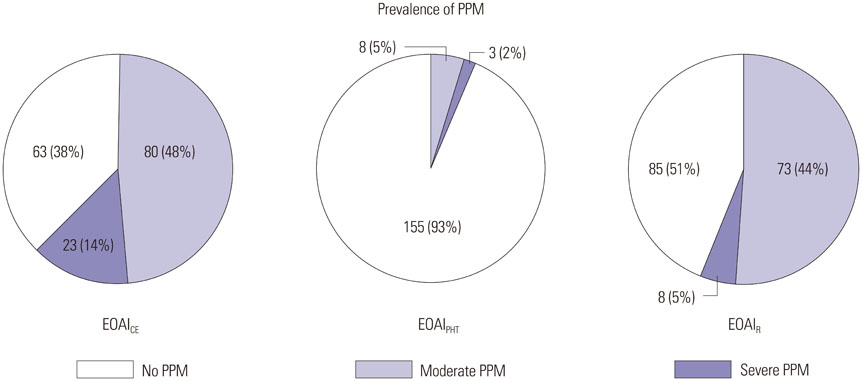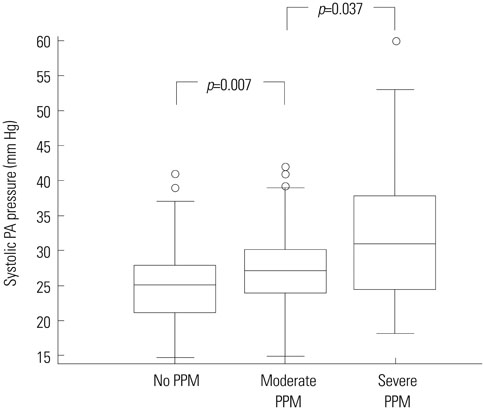Yonsei Med J.
2016 Mar;57(2):328-336. 10.3349/ymj.2016.57.2.328.
Prosthesis-Patient Mismatch after Mitral Valve Replacement: Comparison of Different Methods of Effective Orifice Area Calculation
- Affiliations
-
- 1Division of Cardiology, Severance Cardiovascular Hospital, Yonsei University College of Medicine, Seoul, Korea. grhong@yuhs.ac
- 2Division of Cardiovascular Surgery, Severance Cardiovascular Hospital, Yonsei University College of Medicine, Seoul, Korea.
- KMID: 2374036
- DOI: http://doi.org/10.3349/ymj.2016.57.2.328
Abstract
- PURPOSE
The incidence of prosthesis-patient mismatch (PPM) after mitral valve replacement (MVR) has been reported to vary. The purpose of the current study was to investigate incidence of PPM according to the different methods of calculating effective orifice area (EOA), including the continuity equation (CE), pressure half time (PHT) method and use of reference EOA, and to compare these with various echocardiographic variables.
MATERIALS AND METHODS
We retrospectively reviewed 166 individuals who received isolated MVR due to rheumatic mitral stenosis and had postoperative echocardiography performed between 12 and 60 months after MVR. EOA was determined by CE (EOA(CE)) and PHT using Doppler echocardiography. Reference EOA was determined from the literature or values offered by the manufacturer. Indexed EOA was used to define PPM as present if < or =1.2 cm2/m2.
RESULTS
Prevalence of PPM was different depending on the methods used to calculate EOA, ranging from 7% in PHT method to 49% in referred EOA method to 62% in CE methods. The intraclass correlation coefficient was low between the methods. PPM was associated with raised trans-prosthetic pressure, only when calculated by CE (p=0.021). Indexed EOA(CE) was the only predictor of postoperative systolic pulmonary artery (PA) pressure, even after adjusting for age, preoperative systolic PA pressure and postoperative left atrial volume index (p<0.001).
CONCLUSION
Prevalence of mitral PPM varied according to the methods used to calculate EOA in patients with mitral stenosis after MVR. Among the various methods used to define PPM, EOA(CE) was the only predictor of postoperative hemodynamic parameters.
Keyword
MeSH Terms
Figure
Cited by 2 articles
-
Effect of Patient-Prosthesis Mismatch in Aortic Position on Late-Onset Tricuspid Regurgitation and Clinical Outcomes after Double Valve Replacement
Seung Hyun Lee, Young-Nam Youn, Byung Chul Chang, Hyun Chel Joo, Sak Lee, Kyung-Jong Yoo
Yonsei Med J. 2017;58(5):968-974. doi: 10.3349/ymj.2017.58.5.968.Predictors of Long-Term Outcomes of Percutaneous Mitral Valvuloplasty in Patients with Rheumatic Mitral Stenosis
Darae Kim, Hyemoon Chung, Jong-Ho Nam, Dong Hyuk Park, Chi Young Shim, Jung-Sun Kim, Hyuk-Jae Chang, Geu-Ru Hong, Jong-Won Ha
Yonsei Med J. 2018;59(2):273-278. doi: 10.3349/ymj.2018.59.2.273.
Reference
-
1. Rahimtoola SH. The problem of valve prosthesis-patient mismatch. Circulation. 1978; 58:20–24.
Article2. Pibarot P, Dumesnil JG, Cartier PC, Métras J, Lemieux MD. Patientprosthesis mismatch can be predicted at the time of operation. Ann Thorac Surg. 2001; 71:5 Suppl. S265–S268.
Article3. Pibarot P, Dumesnil JG. Prosthesis-patient mismatch: definition, clinical impact, and prevention. Heart. 2006; 92:1022–1029.
Article4. Angeloni E, Melina G, Pibarot P, Benedetto U, Refice S, Ciavarella GM, et al. Impact of prosthesis-patient mismatch on the regression of secondary mitral regurgitation after isolated aortic valve replacement with a bioprosthetic valve in patients with severe aortic stenosis. Circ Cardiovasc Imaging. 2012; 5:36–42.
Article5. Melina G, Angeloni E, Benedetto U, Refice S, Miceli A, Miele C, et al. Relationship between prosthesis-patient mismatch and probrain natriuretic peptides after aortic valve replacement. J Heart Valve Dis. 2010; 19:171–176.6. Head SJ, Mokhles MM, Osnabrugge RL, Pibarot P, Mack MJ, Takkenberg JJ, et al. The impact of prosthesis-patient mismatch on long-term survival after aortic valve replacement: a systematic review and meta-analysis of 34 observational studies comprising 27 186 patients with 133 141 patient-years. Eur Heart J. 2012; 33:1518–1529.
Article7. Magne J, Mathieu P, Dumesnil JG, Tanneé D, Dagenais F, Doyle D, et al. Impact of prosthesis-patient mismatch on survival after mitral valve replacement. Circulation. 2007; 115:1417–1425.
Article8. Lam BK, Chan V, Hendry P, Ruel M, Masters R, Bedard P, et al. The impact of patient-prosthesis mismatch on late outcomes after mitral valve replacement. J Thorac Cardiovasc Surg. 2007; 133:1464–1473.
Article9. Li M, Dumesnil JG, Mathieu P, Pibarot P. Impact of valve prosthesis-patient mismatch on pulmonary arterial pressure after mitral valve replacement. J Am Coll Cardiol. 2005; 45:1034–1040.
Article10. Sakamoto H, Watanabe Y. Does patient-prosthesis mismatch affect long-term results after mitral valve replacement? Ann Thorac Cardiovasc Surg. 2010; 16:163–167.11. Matsuura K, Mogi K, Aoki C, Takahara Y. Prosthesis-patient mismatch after mitral valve replacement stratified by referred and measured effective valve area. Ann Thorac Cardiovasc Surg. 2011; 17:153–159.
Article12. Aziz A, Lawton JS, Maniar HS, Pasque MK, Damiano RJ Jr, Moon MR. Factors affecting survival after mitral valve replacement in patients with prosthesis-patient mismatch. Ann Thorac Surg. 2010; 90:1202–1210.
Article13. Bouchard D, Vanden Eynden F, Demers P, Perrault LP, Carrier M, Cartier R, et al. Patient-prosthesis mismatch in the mitral position affects midterm survival and functional status. Can J Cardiol. 2010; 26:532–536.
Article14. Jamieson WR, Germann E, Ye J, Chan F, Cheung A, MacNab JS, et al. Effect of prosthesis-patient mismatch on long-term survival with mitral valve replacement: assessment to 15 years. Ann Thorac Surg. 2009; 87:1135–1141.
Article15. Shi WY, Yap CH, Hayward PA, Dinh DT, Reid CM, Shardey GC, et al. Impact of prosthesis--patient mismatch after mitral valve replacement: a multicentre analysis of early outcomes and mid-term survival. Heart. 2011; 97:1074–1081.
Article16. Dumesnil JG, Pibarot P. Prosthesis-patient mismatch: an update. Curr Cardiol Rep. 2011; 13:250–257.
Article17. Zoghbi WA, Chambers JB, Dumesnil JG, Foster E, Gottdiener JS, Grayburn PA, et al. Recommendations for evaluation of prosthetic valves with echocardiography and doppler ultrasound: a report From the American Society of Echocardiography's Guidelines and Standards Committee and the Task Force on Prosthetic Valves, developed in conjunction with the American College of Cardiology Cardiovascular Imaging Committee, Cardiac Imaging Committee of the American Heart Association, the European Association of Echocardiography, a registered branch of the European Society of Cardiology, the Japanese Society of Echocardiography and the Canadian Society of Echocardiography, endorsed by the American College of Cardiology Foundation, American Heart Association, European Association of Echocardiography, a registered branch of the European Society of Cardiology, the Japanese Society of Echocardiography, and Canadian Society of Echocardiography. J Am Soc Echocardiogr. 2009; 22:975–1014.18. Devereux RB, Alonso DR, Lutas EM, Gottlieb GJ, Campo E, Sachs I, et al. Echocardiographic assessment of left ventricular hypertrophy: comparison to necropsy findings. Am J Cardiol. 1986; 57:450–458.
Article19. Sanfilippo AJ, Abascal VM, Sheehan M, Oertel LB, Harrigan P, Hughes RA, et al. Atrial enlargement as a consequence of atrial fibrillation. A prospective echocardiographic study. Circulation. 1990; 82:792–797.
Article20. Zoghbi WA, Enriquez-Sarano M, Foster E, Grayburn PA, Kraft CD, Levine RA, et al. Recommendations for evaluation of the severity of native valvular regurgitation with two-dimensional and Doppler echocardiography. J Am Soc Echocardiogr. 2003; 16:777–802.
Article21. Hatle L, Angelsen B, Tromsdal A. Noninvasive assessment of atrioventricular pressure half-time by Doppler ultrasound. Circulation. 1979; 60:1096–1104.
Article22. Zhang JF, Wu YC, Shen WF, Kong Y. Impact of prosthesis-patient mismatch on survival after mitral valve replacement: a systematic review. Chin Med J (Engl). 2013; 126:3762–3766.23. Angeloni E, Melina G, Benedetto U, Roscitano A, Refice S, Quarto C, et al. Impact of prosthesis-patient mismatch on tricuspid valve regurgitation and pulmonary hypertension following mitral valve replacement. Int J Cardiol. 2013; 168:4150–4154.
Article24. Schwammenthal E, Vered Z, Agranat O, Kaplinsky E, Rabinowitz B, Feinberg MS. Impact of atrioventricular compliance on pulmonary artery pressure in mitral stenosis: an exercise echocardiographic study. Circulation. 2000; 102:2378–2384.
Article25. D'Alonzo GE, Barst RJ, Ayres SM, Bergofsky EH, Brundage BH, Detre KM, et al. Survival in patients with primary pulmonary hypertension. Results from a national prospective registry. Ann Intern Med. 1991; 115:343–349.26. Malouf JF, Enriquez-Sarano M, Pellikka PA, Oh JK, Bailey KR, Chandrasekaran K, et al. Severe pulmonary hypertension in patients with severe aortic valve stenosis: clinical profile and prognostic implications. J Am Coll Cardiol. 2002; 40:789–795.
Article27. Enriquez-Sarano M, Rossi A, Seward JB, Bailey KR, Tajik AJ. Determinants of pulmonary hypertension in left ventricular dysfunction. J Am Coll Cardiol. 1997; 29:153–159.
Article28. Vincens JJ, Temizer D, Post JR, Edmunds LH Jr, Herrmann HC. Long-term outcome of cardiac surgery in patients with mitral stenosis and severe pulmonary hypertension. Circulation. 1995; 92:9 Suppl. II137–II142.
Article29. Crawford MH, Souchek J, Oprian CA, Miller DC, Rahimtoola S, Giacomini JC, et al. Determinants of survival and left ventricular performance after mitral valve replacement. Department of Veterans Affairs Cooperative Study on Valvular Heart Disease. Circulation. 1990; 81:1173–1181.
Article30. Lee S, Lee SH, Chang BC, Shim JK. Efficacy of goal-directed therapy using bioreactance cardiac output monitoring after valvular heart surgery. Yonsei Med J. 2015; 56:913–920.
Article31. Groves PH, Hall RJ. Late tricuspid regurgitation following mitral valve surgery. J Heart Valve Dis. 1992; 1:80–86.32. Lam CS, Borlaug BA, Kane GC, Enders FT, Rodeheffer RJ, Redfield MM. Age-associated increases in pulmonary artery systolic pressure in the general population. Circulation. 2009; 119:2663–2670.
Article
- Full Text Links
- Actions
-
Cited
- CITED
-
- Close
- Share
- Similar articles
-
- A Case of Isolated Congenital Double-Orifice Mitral Valve
- Usefulness of Pressure Half Time by Pulse Doppler Ultrasound in Evaluation of the Severity of Mitral Stenosis
- Congenital Double-Orifice Mitral Valve with Mitral Valve Prolapse and Severe Mitral Regurgitation
- The Prognostic Significance of Patient-Prosthesis Mismatch after Aortic Valve Replacement
- Artificial Heart Valve Replacement





